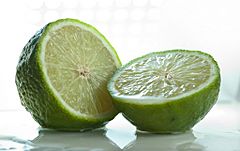Persian lime facts for kids
Quick facts for kids Persian lime |
|
|---|---|
 |
|
| Scientific classification | |
| Kingdom: | |
| Division: | |
| Class: | |
| Subclass: | |
| Order: | |
| Family: | |
| Genus: | |
| Species: |
C. latifolia
|
| Binomial name | |
| Citrus latifolia (Yu. Tanaka) Tanaka
|
|
The Persian lime (Citrus x latifolia) is a popular type of citrus fruit. It is also known as the Tahiti lime or Bearss lime. In many places, it is simply called a "lime." This fruit is very important in the United States, where it is the main type of lime grown for sale.
Persian limes are usually about 6 centimeters (2.4 inches) wide. They are often sold when they are still green, but they turn yellow as they get fully ripe. Compared to the key lime, the Persian lime is bigger and has a thicker skin. It also has a milder smell. Key limes are grown more widely around the world, but Persian limes have some advantages. They have fewer seeds and the plant itself is stronger. Persian lime plants also do not have thorns, which makes them easier to harvest. Plus, the fruit stays fresh longer after being picked.
What Makes Persian Limes Special?
Persian limes are less sour than key limes. They also do not have the slightly bitter taste that key limes are known for. This makes them a favorite for many different foods and drinks.
These limes are grown in many places. A lot of them come from Florida in the U.S. They are also grown, processed, and sent all over the world from places like Martínez de la Torre, Veracruz, Mexico. From Mexico, they go to markets in the Americas, Europe, and Asia. Most of the limes coming into the U.S. from Mexico pass through McAllen, Texas.
History of Persian Limes
Persian limes became much more important after a big event in 1926. A strong hurricane destroyed many key lime farms in Florida. This made Persian limes a more popular choice for farmers. However, Persian lime farms also faced challenges. For example, Hurricane Andrew caused a lot of damage to them in 1992. Despite these challenges, Persian limes continue to be a major crop.
Images for kids
See also
 In Spanish: Limón Tahití para niños
In Spanish: Limón Tahití para niños



